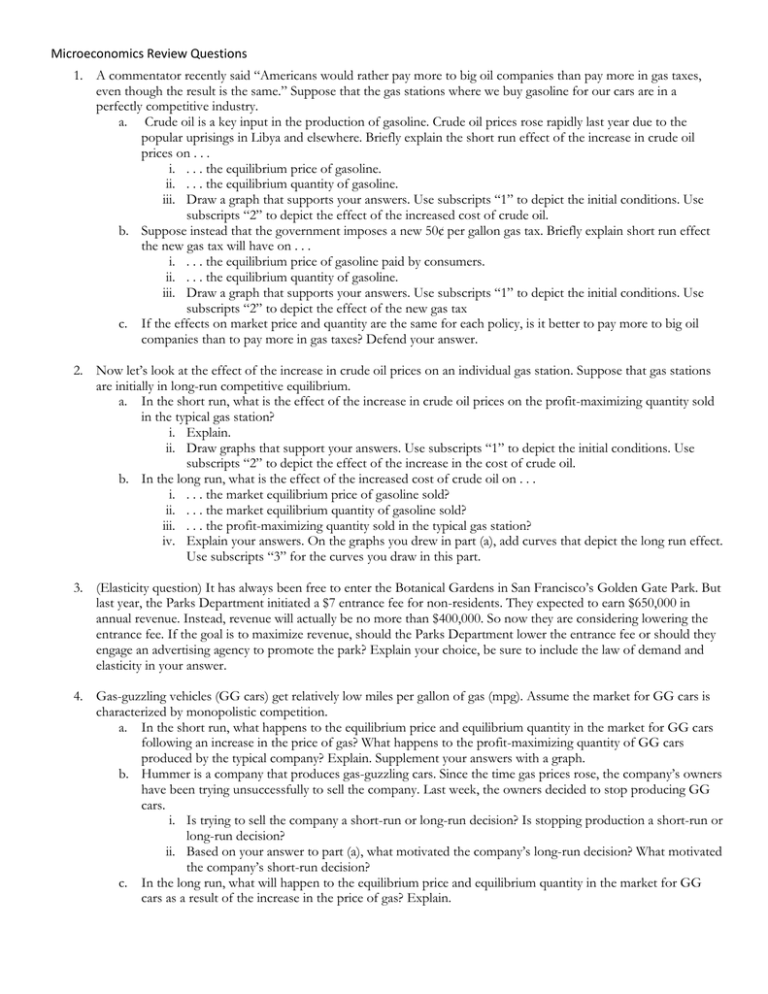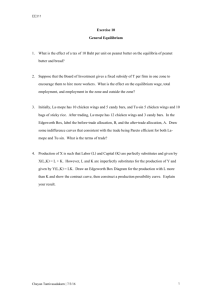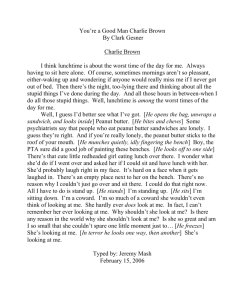Questions - Holt High Economics
advertisement

Microeconomics Review Questions 1. A commentator recently said “Americans would rather pay more to big oil companies than pay more in gas taxes, even though the result is the same.” Suppose that the gas stations where we buy gasoline for our cars are in a perfectly competitive industry. a. Crude oil is a key input in the production of gasoline. Crude oil prices rose rapidly last year due to the popular uprisings in Libya and elsewhere. Briefly explain the short run effect of the increase in crude oil prices on . . . i. . . . the equilibrium price of gasoline. ii. . . . the equilibrium quantity of gasoline. iii. Draw a graph that supports your answers. Use subscripts “1” to depict the initial conditions. Use subscripts “2” to depict the effect of the increased cost of crude oil. b. Suppose instead that the government imposes a new 50¢ per gallon gas tax. Briefly explain short run effect the new gas tax will have on . . . i. . . . the equilibrium price of gasoline paid by consumers. ii. . . . the equilibrium quantity of gasoline. iii. Draw a graph that supports your answers. Use subscripts “1” to depict the initial conditions. Use subscripts “2” to depict the effect of the new gas tax c. If the effects on market price and quantity are the same for each policy, is it better to pay more to big oil companies than to pay more in gas taxes? Defend your answer. 2. Now let’s look at the effect of the increase in crude oil prices on an individual gas station. Suppose that gas stations are initially in long-run competitive equilibrium. a. In the short run, what is the effect of the increase in crude oil prices on the profit-maximizing quantity sold in the typical gas station? i. Explain. ii. Draw graphs that support your answers. Use subscripts “1” to depict the initial conditions. Use subscripts “2” to depict the effect of the increase in the cost of crude oil. b. In the long run, what is the effect of the increased cost of crude oil on . . . i. . . . the market equilibrium price of gasoline sold? ii. . . . the market equilibrium quantity of gasoline sold? iii. . . . the profit-maximizing quantity sold in the typical gas station? iv. Explain your answers. On the graphs you drew in part (a), add curves that depict the long run effect. Use subscripts “3” for the curves you draw in this part. 3. (Elasticity question) It has always been free to enter the Botanical Gardens in San Francisco’s Golden Gate Park. But last year, the Parks Department initiated a $7 entrance fee for non-residents. They expected to earn $650,000 in annual revenue. Instead, revenue will actually be no more than $400,000. So now they are considering lowering the entrance fee. If the goal is to maximize revenue, should the Parks Department lower the entrance fee or should they engage an advertising agency to promote the park? Explain your choice, be sure to include the law of demand and elasticity in your answer. 4. Gas-guzzling vehicles (GG cars) get relatively low miles per gallon of gas (mpg). Assume the market for GG cars is characterized by monopolistic competition. a. In the short run, what happens to the equilibrium price and equilibrium quantity in the market for GG cars following an increase in the price of gas? What happens to the profit-maximizing quantity of GG cars produced by the typical company? Explain. Supplement your answers with a graph. b. Hummer is a company that produces gas-guzzling cars. Since the time gas prices rose, the company’s owners have been trying unsuccessfully to sell the company. Last week, the owners decided to stop producing GG cars. i. Is trying to sell the company a short-run or long-run decision? Is stopping production a short-run or long-run decision? ii. Based on your answer to part (a), what motivated the company’s long-run decision? What motivated the company’s short-run decision? c. In the long run, what will happen to the equilibrium price and equilibrium quantity in the market for GG cars as a result of the increase in the price of gas? Explain. Microeconomics Review Questions 5. Beautiful Island (B.I. for short) and Ugly Mainland (U.M. for short) are two countries that can each produce two products: tourism and education. a. B.I. can produce • (A) lots of tourism and little education, or • (B) lots of education and little tourism Draw a production possibilities frontier (PPF) at the right for Beautiful Island. Show combinations (A) and (B) on your graph. Label everything carefully. If there is no trade, does B.I.’s rate of economic growth depend upon which combination B.I. produces? Explain. b. With trade, B.I. will produce tourism and U.M. will produce education. Under which condition will Beautiful Island have higher rates of economic growth: with trade, or without trade? Explain. 6. Marginal Product in our Airplane factory: Use the paper airplane factory to help answer the following questions about key economic concepts a. What is the law of diminishing returns? b. What is the definition of marginal cost? c. Why does the law of diminishing returns imply that marginal costs increase? 7. Suppose we divide the goods and services produced by Economy A into two categories: Consumption (C) and Investment (I). Investment increases the amount of capital in the economy, and also increases worker productivity. Consumption does not have these benefits. a. Draw a Production Possibilities Model that illustrates Economy A’s production possibilities. Label everything clearly. b. Economy A has a comparative advantage in the production of consumption goods. A near-by economy, Economy B, has a comparative advantage in the production of investment goods. State and briefly discuss one reason the economies may choose to specialize and trade. c. If they chose not to trade, which economy would grow at a faster rate? 8. Peanut butter paste produced at plants in Georgia and Texas recently triggered a salmonella outbreak. (Salmonella is a bacterium that causes food poisoning and sometimes death.) Some snack foods containing peanut butter were recalled and taken off grocery store shelves. Peanut butter in jars does not come from the contaminated factories, does not contain salmonella, is perfectly safe to eat, and was not recalled nor removed from stores. a. Consumers responded to the salmonella outbreak by reducing their purchases of everything containing peanut butter, including peanut butter in jars. i. What impact did their behavior have in the short run on the equilibrium price and equilibrium quantity sold of peanut butter in jars? Why? ii. Draw a graph that supports your analysis. Label everything carefully. b. Skippy is a popular brand of peanut butter in jars. Skippy ran an ad in last week’s paper: “Skippy is not part of the peanut butter recall. Skippy is perfectly safe.” The ad included a coupon for 50¢ off a jar of peanut butter. Would you describe Skippy’s discount coupon as an attempt to change demand or quantity demanded? Why? c. Peanut butter is made from peanuts which are grown by farmers. As a result of the drop in demand for peanut butter products, many farmers have decided they will not plant peanuts this spring. i. Compare next year’s equilibrium price and equilibrium quantity sold of peanut butter in jars with the pre-salmonella-outbreak price and quantity. ii. Would you describe the farmers’ decisions as short run responses or long run responses to the salmonella outbreak? Why? 9. Firm A produces a product with no close substitutes, and there are significant barriers to entering the industry. Firm B is in an industry with no barriers to entry and many firms, but they all produce differentiated products. a. What type of industry is Firm A in? b. What type of industry is Firm B in? c. Which firm can earn profit in the long-run? Why? Microeconomics Review Questions 10. Your aunt and uncle own a small fruit farm in the up north. While you think their fruit is the sweetest in the world, few others can tell the difference between your aunt’s peach and someone else’s. At road’s edge, they have a small store in which they sell fresh produce. Your cousin started advising his parents on their business after taking some Econ courses. But your cousin isn’t explaining himself very well. Now that you’re in Econ, your aunt and uncle have written you a letter asking you to help them understand your cousin’s statements. a. Your aunt and uncle write: “Your cousin told us we are not making a profit. But we cleared $50,000 last year. Why would he say we’re not making a profit?” b. They continue: “Your cousin also told us that we are producing too many peaches. But we are able to sell all the peaches we grow. He drew us some crazy line drawings. Why would he say we’re producing too many peaches? And can you draw those graphs for us and label them clearly?” c. Your aunt and uncle conclude: “Your cousin told us we should shut down our roadside store immediately! He said we should lock the doors of the store and not re-open. What could possibly make him say something like that to us?” 11. The market for pens with red ink (call them “red pens”) is competitive, but businesses can differentiate their products. Like all owners, the owners of pen companies want maximum profit. a. Currently, a firm that sells red pens makes a normal profit at the price of $2 per pen. At the right, draw a graph that depicts this situation. How much economic profit is this firm earning? b. The government imposes a tax of $1 per red pen (but no tax on other colors). What will happen to the quantity of red pens made by the company? Defend your answer and draw a graph that supplements your answer. Label everything carefully. c. After the tax is imposed, does the profit of the typical red pen firm increase, decrease, or stay the same in the near future (say, in the next few weeks)? In one sentence, why? 12. Dairy farmers raise cows which produce milk. But cows also produce manure (that is, poop!). A new invention collects the manure and uses it to produce bio-gas, which can be sold to firms and businesses that use natural gas for power. So dairy farmers can now sell their manure for a higher price than was previously possible. Assume dairy farming is a perfectly competitive industry. a. All else constant, what impact will this invention have on the price of milk? Why? Supplement your answer with a graph. Label everything carefully. b. Dairy farmers hire workers to help raise the cows and workers are paid based on Marginal Product of the workforce and the price of the product the farm is selling. Will this invention increase, decrease, or have no effect on the wages of workers on the dairy farms? Explain. (If you need to make an assumption in order to answer the question, be sure to write down the assumption you make.) 13. Food trucks are essentially take-out restaurants on wheels. They park at the curb, you walk up to order, and they sell you cooked food. There are many successful food trucks in the Lansing area (e.g. El Oasis on Michigan Ave). Each truck offers a slightly different menu. Opening your own food truck business is relatively cheap and easy. a. Would you characterize food trucks as perfect competition, monopoly, or monopolistic competition? Why? b. Last year, the typical food truck owner earned above normal (economic) profit. Draw a graph that illustrates this situation. c. In the long run, would you expect food truck owners to continue earning economic profit? Why or why not? Microeconomics Review Questions 14. Bears have become a problem at Lake Tahoe, even wandering onto the beaches where children play. When families put their household garbage outside in not-bear-proof containers, bears eat the garbage and then return regularly. So local communities around Lake Tahoe now require that families purchase & use bear-proof garbage containers which cost $250 each. Last year, if you put your garbage out in a not-bear-proof container, you had to pay a fine of $100 for the first offense and $500 for the second & each subsequent offense. But you could get back all the money you paid in fines once you bought a bear-proof container. There were still lots of problems with bears last year. This year, the fine is $300 for the first offense, and $1,000 for the second & subsequent offenses and you can’t get the money back after you buy a bear-proof container. a. What is the definition of “negative externality”? Why is “putting household garbage in a not-bear-proof container” an activity that generates negative externalities at Lake Tahoe? b. Compare last year’s fine and this year’s fine: do you think this year’s fine will do a better job, a worse job, or the same job of eliminating the use of not-bear-proof garbage containers? Explain. 15. Where you live in your 30s and 40s is influenced by where you go to school. For example, The state of Iowa offers college scholarships to students in group 1 (graduated high school in Iowa and attend college in Iowa). The state does not offer college scholarships to students in group 2 (graduated high school in Iowa but attend college in another state). If you went to high school in . . . and you went to college in . . . then in your 30s and 40s, you’re likely to live in . . . group 1 Iowa Iowa Iowa group 2 Iowa not Iowa not Iowa a. What is the definition of “positive externality”? b. Without the scholarship program, will the market for education in Iowa create the optimal number of college graduates who stay in Iowa? Why? c. All Iowa residents pay taxes that make the scholarships possible. What would be the benefit of the scholarship program to a typical taxpayer who did not attend college? d. For Iowa residents, will the cost of Iowa’s scholarship program be greater than, less than or equal to the benefit of the program?




